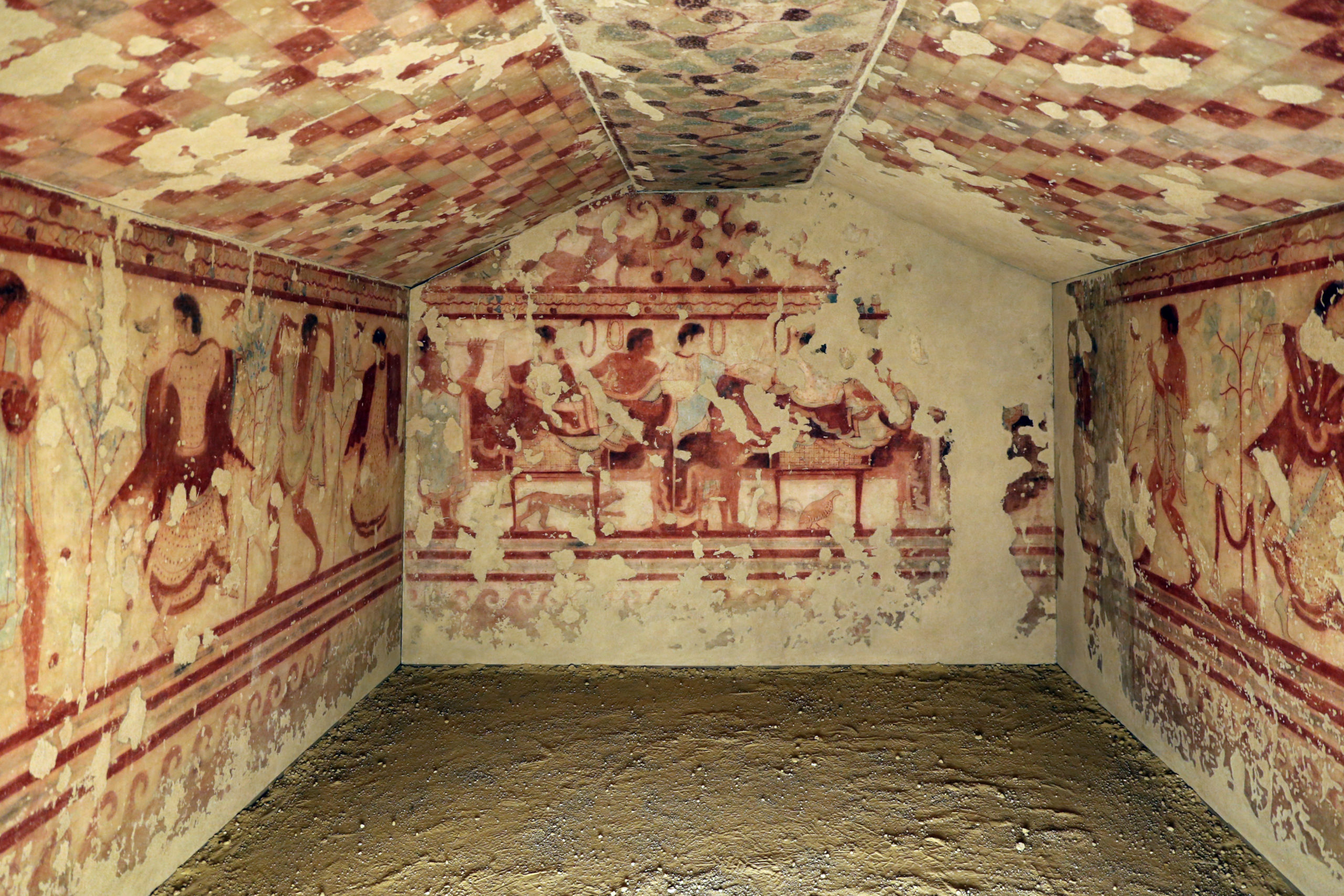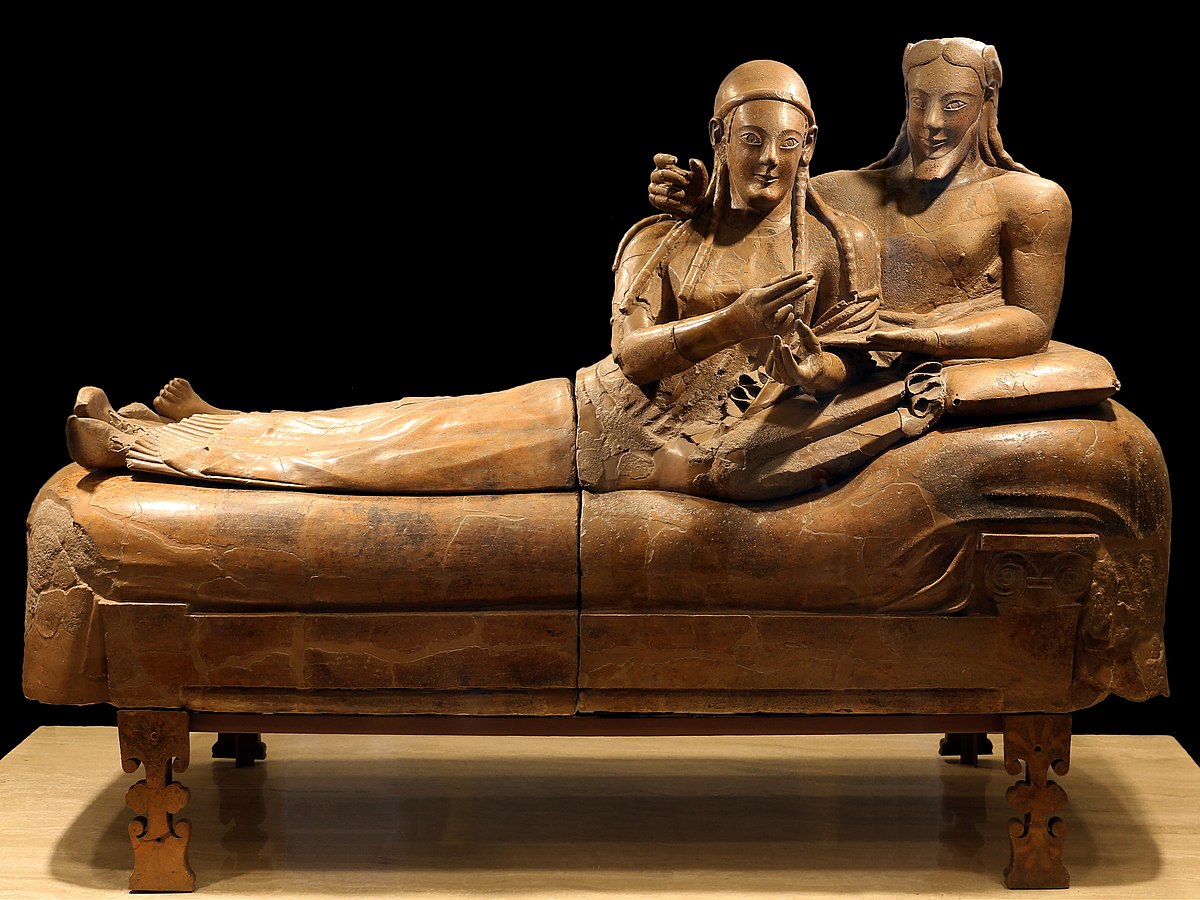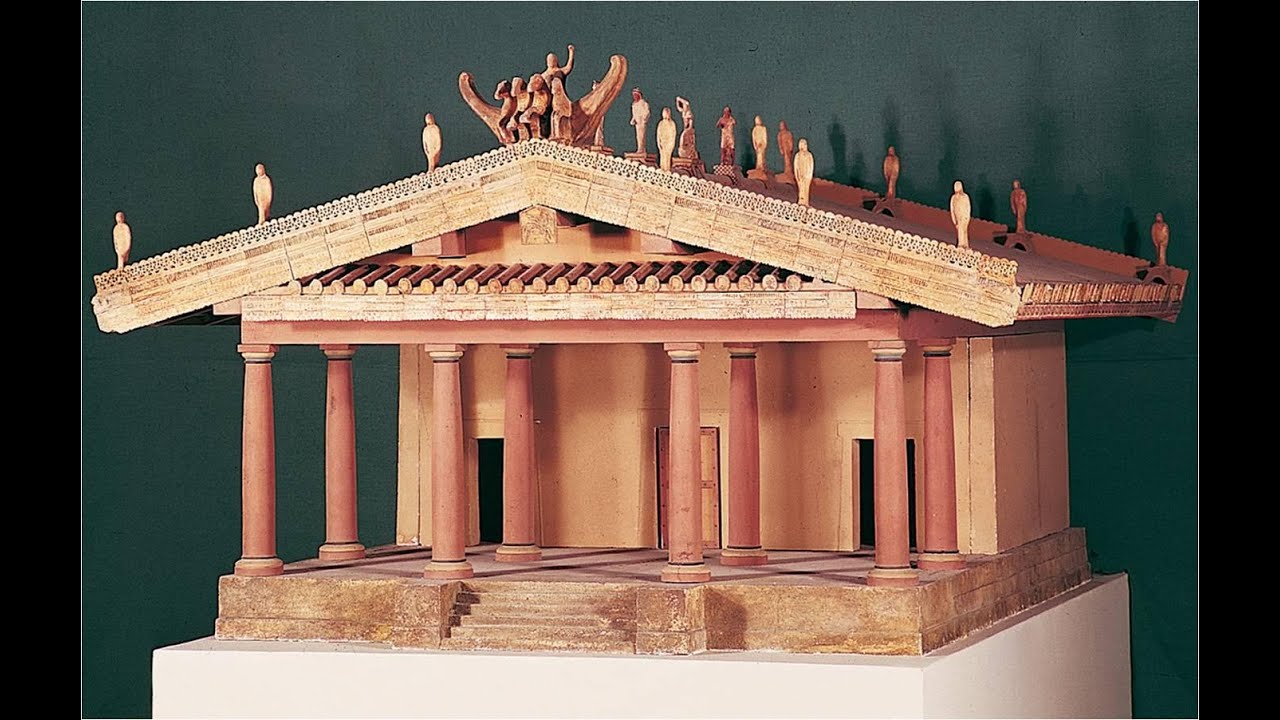Ancient Etruria & Rome
1/15
Earn XP
Description and Tags
Name | Mastery | Learn | Test | Matching | Spaced |
|---|
No study sessions yet.
16 Terms
The Etruscans (800 - 300 BCE)
Existed prior to Rome and would thus influence Rome
Occupied middle of Italy before leading to the foundation and creation of Rome → was eventually conquered by Romans
some of the finest BCE art that would influence Roman art

Tomb of the Triclinium
ETRURIA
Tarquinia, Italy, circa 480-470 BCE, tufa and fresco
tufa = type of limestone
fresco = style of painting
tells us about the decreased and Etruscan society
tumuli = mounds of earth/stones serving as a tomb
emulated the homes of the living for the dead
roughly 6000 tumuli in Tarquinia
form cities for the dead and feature paintings that tell us a lot about Etruscan society
Trinclinim - dining room
dancing figures in the front
painted through fresco technique
buon (true) fresco – plaster is applied to wall, painted while palaster is still wet, paint binds with plaster and becomes part of the painting and is more permanent
secco fresco – doesn’t paint while plaster is wet → have to wait for the plaster to dry before painting, meaning that the paint wouldn’t bind with the fresco and thus wouldn’t last as long
reclining figures in the back
men and women in the same dining room → way different than Greek society, not seen at parties and expected to be in home
women have paler skin and men have darker skin, since they would work outside and women thus wouldn’t get tan since they were expected to stay in the home

Sarcophagus of the Spouses
Eturia, circa 520 BCE, terracotta
comes from large necropolis in Cerveteri
takes the form of a reclining husband and wife on a banqueting couch → life-size
for their sacrophagus, but didn’t hold their bodies → likely held cremated bodies (ashes) of those pictured
can see how funerary rituals differed from Greeks & Romans
woman is most likely holding a jar of perfume & men is holding egg (symbol of regeneration/rebirth) → shows beliefs of Etruscans regarding afterlife
created in 4 separate pieces and was brightly painted at one point
from back angle – figures are actually portrayed awkwardly from the waist down, legs are awkward to create a flat pile of legs, transition from torso to legs is also unnatural and looks uncomfortable

Temple of Minerva at Veii with Apollo Sculpture
Eturia, circa 510-500 BCE, temple, wood, tufa, and mudlock & apollo sculpture – terracotta
Etruscan Gods and their Greco-Roman counterparts (same pantheon of gods under different names)
Tinia – Zeus – Jupiter
Uni – Hera – Juno
Menrva – Athena – Minerva
Apulu – Apollo – Apollo
Artumes – Artemis – Diana
Hercle – Herakles – Hercules
temple is named for Athena, but also holds statues of Apollo and Hercules as well
due to the materials the Etruscans used when constructing their temples, there are actually no remains left → only thing left are the stone foundations
need writing from the Roman architect Vitruvius to piece together model
heavy influence of Greeks on this architecture, but also different
would take Greek ideas and make them something into entirely new
columns at the front were made out of wood, while walls were made of mudbrick
columns are doric order, but not fluted and have base → tuscan columns
Foundation is stone
blueprint – only one way to enter building from the steps in the front that lead us to the porch, have 3 main rooms (sela) for Etruscan versions of Athena, Zeus, and Hera but temple is dedicated to Athena ~ all very different from Greeks
statuary placed on the spine of the roof, not in pediments
Apulu as he confronts Hercles during one of his 12 tasks and at one point depicted one of the 12 models so he could steal Athena’s golden hind
NOT A GREEK WORK even though there’s an archaic smile
The Romans (753 BCE-476 CE)
overthrows the Etruscans → Republican Rome – 509 - 27 BCE
rule of Augustus (Octavian) begins → Imperial Rome – 27 BCE - 284 CE
Constantine I comes into power,splits Rome in 2 → Late Imperial Rome → 284 - 476 CE
Head of a Roman Patrician
REPUBLICAN ROME
circa 75-50 BCE, marble
Wealthy aristocrats during the Republican Rome period were very proud of their lineage, so sculptures is how they celebrated their status
gravitas (serious) & veristic (realistic)
NOT CLASSICAL GREEK
men have wrinkled and aged b/c they were ruling Rome ~ can see how they were from a family who was proud of their lineage
memory must be kept alive
how does this show wealth/power
function: showed lineage and power (aristocratic rule) & ancestor worship was absolutely central to the Romans’ beliefs about death and the afterlife
House of the Vetti
IMPERIAL ROME
Pompeii, Rome, circa 2nd century BCE and rebuilt 62-79 CE, cut stone and fresco
79 CE – Mount Vesivius erupted and killed many, covering the surrounding area in ash, thus ensuring its preservation
House gives explanation to the daily lives of the Romans
first enter through the fauces, then to atrium → where busts of wealthy family members that came before would be
within atrium → there is an opening in the ceiling called the compluvium, which allows rainwater to fall into a basin called the impluvium
compluvium allowed sunlight into the room and thus into the house
past copluvium, there’s the peristyle (columned porch) that circled the garden and provided light, served as a gathering place during the warm months
Throughout the house, there ae cubliciums (bedrooms/places of rest) → SOLELY TO SLEEP
tricliniums – dining room
eruption of Pompeii also preserved Roman painting styles
First Style: incrustation style (fake marble – marble is expensive, so the house looked more expensive)
Second Style: architectural style (architectural realism – making house seem bigger)
Third Style: ornate style (monochrome with linear design)
Fourth Style: intricate style (everything that came before)
Alexander Mosaic from the House of Faun
IMPERIAL ROME
Pompeii, Italy, circa 100 BCE, mosaic
Roman mosaic copy of a Greek painting between King Darius of Persia and Alexander the Great (that painting no longer exists)
Alexander is completely in control no matter the chaos of the situation, sword ends in one of Darius’s soldiers
Darius is in the middle of turning his chariot around
one of Darius’s soldiers is whipping his horse, depicting a previously-unseen POV of horse
man who has fallen and looking into his shield and sees reflection of face
another man who has fallen could be trampled
the original painting was lost to time b/c most Greek paintings were made of wood, but it had to have been so incredibly detailed that the mosaicist who created this work was able to make shadows and variations in color from it
tesserae – small pieces of stone/glass that can be cut to a desired size/shape
by combing stones, you have an image from blocks of color that is more clear the farther you are away
Augustus of Prima Porta
IMPERIAL ROME
early 1st century CE, marble
from the villa of Livia in Prima Porta
Rise of Augustus
44 BCE – Julius Caesar is assassinated & Rome enters a civil war
31 BCE – Octavian, Caesar’s adopted son, defeats Marc Antony and Cleopatra, thus consolidating power
27 BCE – Roman senate declares Octovian as Augustus (renamed, basically)
Rome turns from a republic to an empire
many Romans wouldn’t have seen the emperor, so status were how the masses would’ve seem Augustus ~ basically a form of propaganda
this figure differs from Republican Portraiture → chooses to display himself as a healthy, spry youth (similar to classical Greek period) Augustus is wearing armor, which has famous diplomatic figures depicted with the gods watching over him
continued propaganda, with these diplomatic figures to provide a sense of control over the empire for the Roman people
Julian family linage through Venus is reinforced → nude infant (Cupid) is grabbing at Augustus’s clothes
Cupid, Venus’s daughter with Augustus → reinforcing he came from a goddess and his family is aligned with a goddess
Flavian Amphitheater (The Colosseum
IMPERIAL ROME
Rome, Italy, circa 70-80 CE, stone and concrete
an amphitheatre is two theaters (theater is half a circle/oval) combined to create a circle/oval
built by Vespasian [of the Flavian (Flavius) family] on Nero’s Domus Aurea (palace with artificial lake)
Before the rule of the Favians, there was a ruler named Nero was horrible → ruled during a horrible fire, so afterwards he rebuilt the city but only built a palace for himself and other monuments (nothing for the people)
after death → civil unrest until Vespasian was in power, so he built public spaces over Nero’s monuments
Flavian Amphitheater was constructed over Nero’s Domus Aurea → gave back this land to the Roman people that was originally theirs and taken from the Roman people by Nero
Amphitheater was completed by Titus, son of Vespasian & named after a colossal state of Nero that stood nearby (Coliseum)
Exterior of Coliseum
IMPERIAL ROME
lowest/first level – Tuscan columns (NOT DORIC)
Second level – ionic columns
Third level – corinthian order
Corinthian – acanthus-style leaves that adorn the capital, flashiest, Romans loved this b/c it was flashy but Greeks didn’t
base
fluted shaft and continues to taper (get thinner) towards top
highly decorated capital with acanthus leaves
Embalutre – archave is similar to orders
Continuous frieze
No pediment → flat roof
Concrete was a huge deal
Colloseum looks like this today (originally had marble seats and originally looked more extravagant) b/c after the fall of Rome, it would’ve been used as a shop and stripped of its original stuff, so we can see what was originally there (concrete skeleton)
Evolution of the Arch
IMPERIAL ROME
post & lintel (flaw was that it could only be built so wide before it cracked in the middle) → corbeled (created by stacking stones until they met at the point, but if one of them were to fall, the whole arch would fall) → rounded (allowed Colloseum to be constructed, same principle as corbleled but rounded and allowed for barrel vaults)
Vaults (why the rounded arch matters)
IMPERIAL ROME
extending round arch leaves a hallway with a rounded arch roof → barrel vault
in a barrel vault, the weight of the vault is pushed downwards and outwards, thick walls called buttresses to keep it from falling in
modern-day arenas are modelled after this
when two barrel vaults intersect, a groin vault formed and is lighter w/less material, weight is channeled towards into a thick column called a pier
Fenestrated groin vault appears when a groin vault covers an interior hall and creates the equivalent of a clerestory (windows)
allows light to filter in
dome → where a rounded arch is rotated around the full circumference of a circle and rests on drum (walls-ish)
Forum of Trajan
IMPERIAL ROME
designed by Apollodorus of Damascus, Rome, brick and concrete; column dates to 113 CE, marble
forum = “a public, urban square for civic and ritual business”
Trajan followed a terrible ruler called Domission → Trajan was the first non-Italian to rule Rome and expanded many projects for the people of Rome
Forum of Trajan featured several buildings
when you first enter, you see an equestrian statue of Trajan
has an overriding martial theme, reminding viewers and visitors that the forum was constructed from the proceeds of Trajan’s successful military campaigns against the Dacians (101-102, 105-106 CE)
the porticoes were decorated with military and statuary standards
all along the roof of the colonnades of the forum of trajan gilded statues of horses and representations of military standards were placed, and underneath
basilica upla
Ulpius = Trajan’s family name
Cuts form into 2
Seaprates library & temple from open space when you first entered
Had huge impact on Christianity → would look to the basilica as an ideal space to hold many people at once
Left & right side – semicircular caps on the sides (apse)
Nave – central column in middle
Entrances aren’t with apses, but actually enter through longer sides
Elevation of building to allow light in → influence from Egyptian hypostyle halls
Trajan’s column
128 ft tall
Nude trajan replaced with St. Peter in the 16th century
Columns celebrate the victory over the Dacians → created band that wrapped and sprialed from bottom to top
lower half – first war
upper half – second war
Frieze is 625 ft long
Base is Trajan’s tomb
inside doorway,
Scenes would’ve been painted and easier to decipher
Library
temple of Trajan
Trajan would be considered a god after he died, so a temple was buillt for him
Markets of Trajan
Home to shops & administrative offices
Lit, open interior space accomplished through vaulting
Pantheon
IMPERIAL ROME
Rome, Italy, 118-125 CE, stone (granite) facing with concrete
constructed by Hadrian, hand-picked successor to Trajan (died while it was being built)
Pantheon = temple dedicated to every god
Dedicated to marcus Agripa, who made a pantheon earlier in history
Rotunda (Roman innovation), portico (alludes to past), and colonnade that’s no longer there
Perfect circle found inside
142 tall & wide
Weight allows the dome to be constructed in a such a great manner
Coffers = recessed panels in a ceiling/dome → help to decrease weight of structure and removes some building material for the sake of the design
Oculus is like heaven
Opening in dome ceiling allows light to be let in
Volcanic rock used near top? Pozzalana (light)
Material used near bottom? Basalt (heavy)
Apollodarus of damascus was the architect for the forum of trajan, but since hadrian didn’t like him, he banished and killed him b/c he told hadrian he didn’t understand anything
Ludovisi Battle Sarcophagus
LATE IMPERIAL ROME
circa 250 CE, marble
eastern religion began to influence Romans → Christianity
Believed in needing body to ascend, so more burials → led to creating a sacrophagus for the body
war scene between Romans and Barbarians
What’s important is how the artist chose to portray the scene
Created layers of human beings, in cartoonish way, similar to how people were depicted in middle ages on cathedrals
Roman art is reaching its transitional point to more Christian influence
In Christian art, realism doesn’t matter, but the story being told